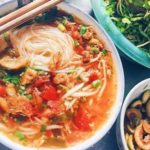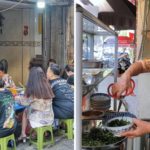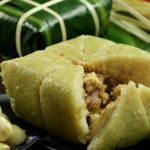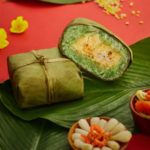In today’s globalized world, English is the second most important language after the native tongue of Vietnamese people. It is evident that children in each family, even before they are of school age, are taught English at home by their parents on familiar topics such as greetings, counting, and food names. Speaking of food, one cannot overlook the traditional dishes during the Lunar New Year, as Vietnamese culinary culture is incredibly rich and diverse.
Here are some traditional Lunar New Year dishes that you can teach your child about in English:
1 Five Fruit Tray
 Some related vocabulary in Lunar New Year dishes
Some related vocabulary in Lunar New Year dishes
The Five Fruit Tray is an essential part of the offerings presented on the ancestral altar in every household. In Southern Vietnam, people usually use fruits such as jackfruit, coconut, papaya, mango, and jujube, symbolizing a wish for sufficient money and a prosperous family. However, you can also use other fruits if you prefer and create your own meanings based on the names of those fruits.
– ‘Ngũ’ means ‘five’ in Vietnamese – the English equivalent is ‘five’.
Pronunciation:
– Fruit (/ˈfruːt/): refers to the product of a plant that contains seeds and can be eaten as food.
– Tray (/ˈtreɪ/): a flat, shallow container with a raised edge, used for carrying, holding, or serving food. Synonym: Plate (/ˈpleɪt/).
Combining these words, we get Five Fruit Tray or Five Fruit Plate, both of which mean ‘mâm ngũ quả’ in Vietnamese.
2 Sticky Rice Cakes
 Sticky Rice Cakes
Sticky Rice Cakes
The origin of these cakes can be traced back to the legend of Lang Liêu, a prince who offered these cakes to his father, the king, during the Lunar New Year (the folk tale of Bánh Chưng, Bánh Giầy). Since then, the cakes have become a traditional food for the holiday, and the story is often retold by grandparents to their grandchildren.
The main ingredient of these cakes is glutinous rice, and their names are derived from their shape and primary ingredient.
Pronunciation:
– Sticky Rice (/ˌstɪk.i ˈraɪs/): rice with a high amount of amylopectin starch, giving it a sticky texture when cooked.
– Cake (/ˈkeɪk/): a sweet, baked food item, typically made with flour, eggs, and sugar.
– Square (/ˈskwɛr/): a four-sided shape with four right angles and four equal sides.
– Round (/rɑʊnd/): having a flat, circular shape.
– Cylinder (/ˈsɪ.lən.dɜː/): a solid geometric shape with straight parallel sides and a circular or oval cross-section.
Combining these words, we get:
Sticky Rice Cake (bánh chưng, bánh giầy) or Square Sticky Rice Cake (bánh chưng – square-shaped cake) or Round Sticky Rice Cake (bánh giầy – round-shaped cake) or Cylinder Sticky Rice Cake (bánh tét – cylinder-shaped cake).
3 Meat Stewed in Coconut Juice
 Meat Stewed in Coconut Juice
Meat Stewed in Coconut Juice
This dish is a must-have during the Lunar New Year celebrations. It is typically served with pickled vegetables or small leeks and enjoyed with white rice. The main ingredients are pork and duck eggs, slowly cooked in coconut juice, resulting in a delicious and tender meat dish.
Meat Stewed in Coconut Juice (thịt kho nước dừa)
Meat Stewed: Refers to the process of slowly cooking the meat in a sauce or liquid.
Coconut Juice: The liquid extracted from coconuts, known for its sweet and nutty flavor.
You can also learn some vocabulary related to the ingredients used in this dish:
Egg (/ˈɛɡ/): An animal product, usually from a chicken, consisting of a round or oval object with a shell and a yolk and white inside, eaten as food.
Fish Sauce: A condiment made from fermented fish, commonly used in Southeast Asian cuisine, including Vietnamese cooking.
4 Pickled Small Leeks
 Pickled Small Leeks
Pickled Small Leeks
Pickled Small Leeks, or dưa kiệu, is a white-colored pickle made by soaking leeks in vinegar, rock sugar, and other ingredients. It has a similar flavor to pickled onions but with a stronger aroma and a smaller size, resembling garlic cloves. It is commonly served with nem chua (fermented pork) or chả lụa (Vietnamese pork sausage).
Pickled Small Leeks: Dưa kiệu or củ kiệu in Vietnamese.
Pronunciation:
Pickled (/ˈpɪ.kəl/): Foods that have been preserved in a brine or vinegar solution, giving them a sour taste.
Leeks ([lik]): A vegetable related to onions, with a mild onion-like flavor and a long, thick white bulb and long green leaves.
Small (/ˈsmɔl/: Of limited size or extent.
5 Ginger Jam
 Ginger Jam
Ginger Jam
Ginger jam is a familiar treat to Vietnamese people, especially during the Lunar New Year, as the weather tends to get cooler. It is heartwarming to gather with family and enjoy a hot cup of tea with some ginger jam during this festive season.
– Ginger Jam: Mứt gừng in Vietnamese.
Pronunciation
– Ginger (/ˈdʒɪn.dʒɜː/): A knobby, tan-colored root with a pungent, spicy flavor, used as a spice or medicine.
– Jam (/ˈdʒæm/): A sweet spread or preserve made from crushed fruit boiled with sugar.
6 Spring Rolls
 Spring Rolls
Spring Rolls
Spring rolls are a delicious and crispy treat, deep-fried to perfection. They are made with various ingredients, including pork, mung beans, taro, and other vegetables, all wrapped up in a perfect roll. These rolls are commonly served during gatherings with friends, weddings, and especially during the Lunar New Year, symbolizing the essence of spring wrapped up in a delicious treat.
The English term for this dish is Spring Roll:
Pronunciation
– Spring (/ˈsprɪŋ/): One of the four seasons, characterized by warmer temperatures and the emergence of new plant life.
– Roll (/ˈroʊl/): To wrap something, especially food, around something else, usually to form a cylinder shape.
7 Other Related Vocabulary in Traditional Lunar New Year Dishes
 Other Related Vocabulary in Traditional Lunar New Year Dishes
Other Related Vocabulary in Traditional Lunar New Year Dishes
– Watermelon ( /ˈwɔː.təˌmel.ən/): A large, round or oval fruit with a green rind and sweet, juicy, usually red or pink flesh, eaten as a dessert or refreshing snack.
– Coconut (/ˈkoʊ.kə.ˌnət/): The large, hard-shelled fruit of the coconut palm, consisting of a thick, fibrous husk surrounding a hollow shell that contains a white, fleshy substance and a liquid known as coconut milk or coconut water.
– Mango (/ˈmæŋ.ˌɡoʊ/): An oval-shaped stone fruit with a thin, smooth skin, a large central seed, and sweet, juicy, orange-yellow flesh.
– Papaya (/pə.ˈpɑɪ.ə/): A large, oval fruit with a thin, green or orange skin and sweet, juicy, orange flesh, containing small, black, edible seeds.
– Pickled (/’pikl/) onion (:/ˈən.jən/): Small onions that have been preserved in a brine or vinegar solution, giving them a sour taste.
The topics mentioned above provide a valuable opportunity to teach your child new vocabulary and help them understand the culinary culture of Vietnam.






































